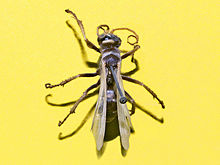
The genus Argiope includes rather large spiders that often have a strikingly coloured abdomen. These spiders are distributed throughout the world. Most countries in tropical or temperate climates host one or more species that are similar in appearance. The etymology of Argiope is from a Latin word argentum meaning silver. The carapace of Argiope species is typically covered in silvery hairs, and when crawling in the sun, they reflect it in a way that gives them a metallic, white appearance.

Wasps in the family Pompilidae are commonly called spider wasps, spider-hunting wasps, or pompilid wasps. The family is cosmopolitan, with some 5,000 species in six subfamilies. Nearly all species are solitary, and most capture and paralyze prey, though members of the subfamily Ceropalinae are kleptoparasites of other pompilids, or ectoparasitoids of living spiders.

Araneus is a genus of common orb-weaving spiders. It includes about 650 species, among which are the European garden spider and the barn spider. The genus was erected by Carl Alexander Clerck in 1757.

Argiope bruennichi is a species of orb-web spider distributed throughout central Europe, northern Europe, north Africa, parts of Asia, and the Azores archipelago. Like many other members of the genus Argiope, it shows striking yellow and black markings on its abdomen.

Argiope aurantia is a species of spider, commonly known as the yellow garden spider, black and yellow garden spider, golden garden spider, writing spider, zigzag spider, zipper spider, black and yellow argiope, corn spider, Steeler spider, or McKinley spider. The species was first described by Hippolyte Lucas in 1833. It is common to the contiguous United States, Hawaii, southern Canada, Mexico, and Central America. It has distinctive yellow and black markings on the abdomen and a mostly white cephalothorax. Its scientific Latin name translates to "gilded silver-face". The body length of males range from 5–9 mm (0.20–0.35 in); females range from 19–28 mm (0.75–1.10 in). These spiders may bite if disturbed or harassed, but the venom is harmless to non-allergic humans, roughly equivalent to a bumblebee sting in intensity.

Argiope argentata, commonly known as the silver argiope due to the silvery color of its cephalothorax, is a member of the orb-weaver spider family Araneidae. This species resides in arid and warm environments in North America, Central America, the Caribbean and widely across South America. In the USA, it is found at least in Southern California, Florida, Arizona, Texas. A. argentata create stabilimenta and a unique zig-zag in its web design, and it utilizes its UV-reflecting silk to attract pollinating species to prey upon. Like other species of Argiope, its venom is not harmful to humans; however, it can be employed to immobilize its prey. A. argentata engages in sexual cannibalism either mid- or post-copulation. One aspect of particular interest regarding this species is its extinction patterns, which notably have minimal correlation with its population size but rather occur sporadically for the species.

Argiope trifasciata is a species of spider native to North and South America, but now found around the world. It can be found in certain areas of Europe, namely the Iberian Peninsula, the Canary Islands, and Madeira. The similar looking Argiope bruennichi is common in the Azores. They typically begin to appear during autumn from early September to late October as temperatures start dropping.
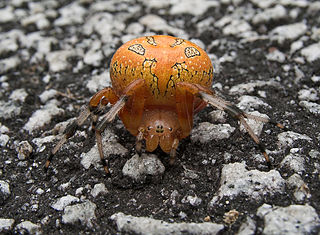
Araneus marmoreus, commonly called the marbled orbweaver, is a species of spider belonging to the family Araneidae. It is sometimes also called the pumpkin spider from the resemblance of the female's inflated abdomen to an orange pumpkin. It has a Holarctic distribution.

Argiope catenulata, also known as the grass cross spider, is a species of orb-weaver spiders ranging from India to the Philippines and Papua New Guinea, and also found in Australia in 2019. Like other species of the same genus, it builds a web with a zig-zag stabilimentum.
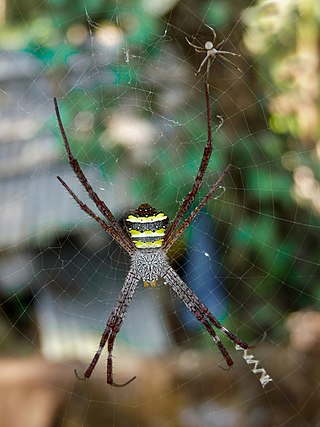
Argiope pulchella is a species of the orb-weaver spider family, Araneidae. It ranges from India to China and can be found on Java. It is a synanthropic species, often living in habitats associated with humans.

Spiders are air-breathing arthropods that have eight legs, chelicerae with fangs generally able to inject venom, and spinnerets that extrude silk. They are the largest order of arachnids and rank seventh in total species diversity among all orders of organisms. Spiders are found worldwide on every continent except for Antarctica, and have become established in nearly every land habitat. As of August 2022, 50,356 spider species in 132 families have been recorded by taxonomists. However, there has been debate among scientists about how families should be classified, with over 20 different classifications proposed since 1900.

Episyron rufipes, the red-legged spider wasp, is a red and black or completely black spider-hunting wasp.
Homonotus sanguinolentus, the bloody spider-hunting wasp is a European species of Pompilid wasp.

Caliadurgus fasciatellus is a species of spider wasp from the subfamily Pepsinae found from Western Europe to the Far East of Asia.
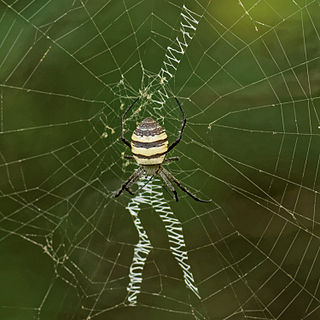
Argiope aemula, commonly known as the oval St Andrew's cross spider, is a species of spider in the family Araneidae which is native to southeast Asia, ranging from India and Sri Lanka to the Philippines, Indonesia, and Vanuatu. It is one of the giant, conspicuous "signature spider" species of the genus Argiope, observed in tropical and subtropical grasslands.

Batozonellus is a genus of the spider hunting wasps.

Poecilopompilus algidus is a species of spider wasp which is widespread in the Americas.

Araneus trifolium, the shamrock orbweaver, is a species of orb weaver in the family Araneidae. It is found throughout the USA and in Canada.
The abdomen of Araneus trifolium can have various colors. Most commonly, it is seen in a beige or brown color. Occasionally, the abdomen of the spider has a greenish touch to the brown color or it may even be yellow or orange. In the latter case, Araneus trifolium is sometimes confused with the orange orb weaver species Araneus marmoreus, also called pumpkin spider. The shamrock spider can be distinguished from other orb weaver species by the several white dots on its back. The legs of Araneus trifolium are usually brown or beige colored with several white bands around the joints.
The shamrock spider creates a web to catch its prey. Small flying insects who fly into the web will get stuck in the sticky net. The web of an orb weaver can be up to two feet (60cm) in diameter.
The bite of a shamrock spider can be painful but it is not dangerous for humans with effects comparable to a bee sting.
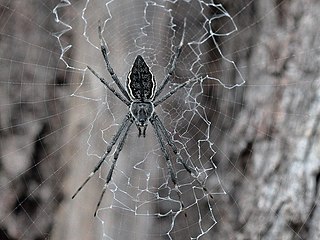
Argiope ocyaloides is a species of orb-web spider found in Queensland, Australia. It is commonly known as bark-hugging St Andrews cross spider.Argiope ocyaloides can be found in crevices of dark coloured bark on eucalypt, acacia, or similar trees. It is smaller than most other species of Argiope and is dark brown to black in colour. The abdomen of Argiope ocyaloides is long with a pointed tip whereas the similar species Argiope mascordi has a shorter abdomen with rounded tip.

Argyrodes antipodianus, also known as the dew drop spider, is a species of kleptoparasitic spider from the cobweb spider family found in Australia, New Zealand and New Caledonia.
